

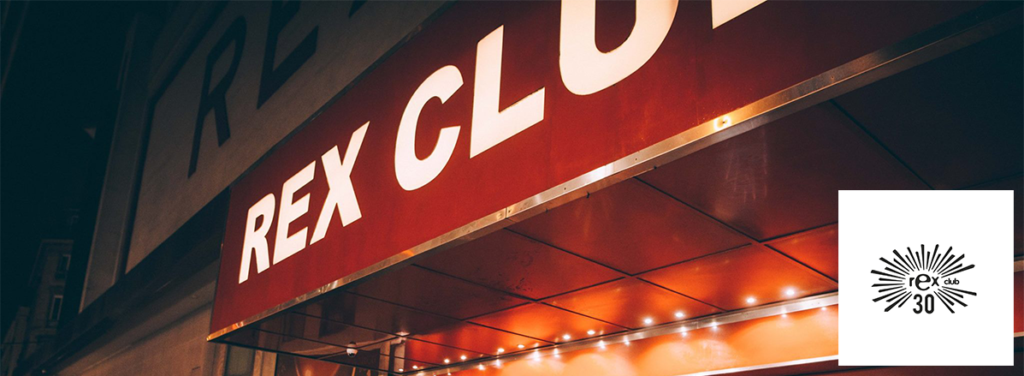
The Rex Club likes to kick off each new decade with a big splash. It was only natural then for it to throw a party in celebration of its 30th anniversary, a milestone that made it as one of the oldest techno clubs in existence.
The club celebrated its achievement with a series of events, some of which took place at other venues, throughout 2018. When the venue first opened in 1946, it was a chic dance hall with an in-house orchestra, known as Le Rêve. It was later renamed Rex Club in 1973 as a nod to the famous movie theater in the same building. The Rex chose to celebrate its 30th anniversary in 2018 in commemoration of its very first Jungle night in May 1988. The event was organized by a group of British promoters who wanted to export their “acid house” sound. Longtime Rex manager Christian Paulet described the events of that Tuesday night to the magazine Trax, saying, “It was nowhere near a full house, but something important happened that evening.” Under the guidance of Laurent Garnier, who thought of the Rex Club as a second home, and Christian Paulet, who switched the venue over to electronic music fully in 1998, the Boulevard Poissonnière club has left its mark on the history of techno in France. Rex Club remains an iconic venue for music fans, even if competition from other clubs, like Concrete, Badaboum, and La Station, and new, sometimes underground events in the suburbs, like Péripate and Possession, has had an undeniable effect on its business. Throughout the year, the club hosted movie showings, special concerts in the main Grand Rex cinema hall (St Germain as well as the Lamoureux orchestra performing the music catalog of the Ed Banger record label), and talented DJs as part of its birthday celebration, which was dubbed “Rexist.”
The coma and subsequent death of a Parisian club-goer on March 10 called attention to the deadly risks of GBL and the drug’s increasing popularity in the party circuit over the past few months. The product, known as gamma-butyrolactone, is used by manufacturers to create a solvent to dissolve polymers and remove graffiti or certain other types of paint. In the body, the substance is transformed into GHB, which is reputed to trigger euphoria and lower inhibitions. GHB has been around since the 1990s. At the time, it was known as the “date rape drug” because it was often slipped into unattended drinks at dance clubs. Clubs started serving drinks with plastic lids to combat the problem. Even though it seems nonsensical to ingest such a dangerous product, its low cost at around €10 for 100 ml (with a typical dose being just 2 ml) and its ease of access (users don’t have to go on the darkweb to find it) have nevertheless attracted the attention of a growing number of users. In Paris, it is clear that GHB/GBL has made its way into free parties and dance clubs. Known simply as “G”, its nickname makes it no less dangerous. To address this issue, the collective Action Nuit, a think tank made up of music industry professionals, sent a letter to the French Ministries of Health and the Interior requesting help for a situation they can’t solve on their own. According to the chief of police, hospitals treat 100 GBL-induced coma cases a year, compared to the dozen or so cases they saw just a few years ago.
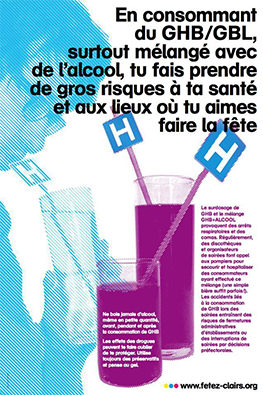


For any artist, a concert at the prestigious venue on Boulevard des Capucines in Paris is a sign that they’ve truly made it—especially when the show is sold out months in advance. That was the case for Carpenter Brut’s live show on March 24. The producer took to the stage along with two heavy-hitting musicians from the metal scene. The artist, whose new album, Leather Teeth, was released a few weeks prior, performed with a powerful set design and rocked the house. His volcanic electro sound has evolved over time towards hard-disco but remains excellent.
The movies and Arnaud Rebotini are a match made in heaven. Following his smash-hit cover of the popular blues song “I’m a Man”, which was featured in several TV series, movies, and ads, Rebotini received the 2018 César for Best Original Movie Score for his work on 120 BPM by Robin Campillo, which tells the story of the association Act Up. Visibily moved, the artist received the award on stage from Eddy Mitchell. His brief and poignant speech, in which he stated, “Act Up still exists, and AIDS is not just a movie,” was especially memorable. This marked the second time Campillo and Rebotini had worked together after Eastern Boys. The director had long been a fan of Rebotini’s work and was impressed by the musical culture and creative breadth of an artist who was just as at ease with techno, electro-influenced blues (which he composed under the name of Blackstrobe), house, and sophisticated and refined pop experimentations, created under the name of Zend Avesta. Like the DJ Ivan Smagghe, Arnaud Rebotini once sold records at Rough Trade, a store that became one of the focal points for the Parisian scene in the early 1990s. Since then, Rebotini has become a prolific musician and a pillar of French music. However, he is also an artist who prefers to stay out of the limelight, contrary to what his rugged cowboy appearance might suggest. In comparison to other French Touch musicians, Rebotini is less well known to the public and not featured on magazine covers nearly as often. Despite his central role in the movement, he remains an outsider. His César was a well-deserved recognition and served to call attention to his work. Rebotini has performed live and as a DJ ever since. His 2018 tour had over 100 stops. While continuing work on his next album, which will be released under one of his pseudonyms, Arnaud Rebotini also composed the original score for the movie Le Vent Tourne featuring Mélanie Thierry.
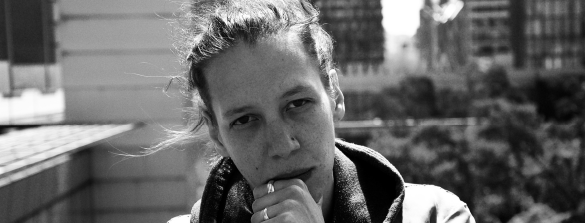
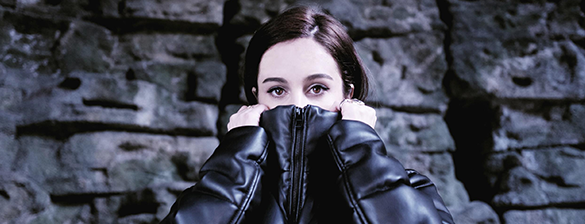

Even as the #metoo movement encouraged women to speak out, they continued to be marginalized in the techno scene despite the key role played by French pioneers like Sextoy, Miss Kittin, Chloé, and Jennifer Cardini. Nevertheless, there are many artists who are pushing the boundaries of French electronic music with just as much (if not more) style as any male DJ. Instead of reproducing the kind of music typically heard in clubs, this generation of DJs is experimenting with volatile combinations to create a radical and explosive party atmosphere. Among this group of pyrotechnical whiz-kids, AZF and her collective, Qui Embrouille Qui, have set the standard. AZF is an expert in intense, industrial-style techno and performed everywhere in 2018, including Concrete, Boiler Room, Rinse FM, Astropolis, Dour, Nördik Impakt, Nuits Sonores, and La Station. At the latter, she organized a festival with her friend Charles Crost from Turc Mécanique to showcase French artists from alternative electronic scenes. Another rising star, DJ Anetha, whose skill at the turntable has few rivals, specializes in an unapologetic version of techno influenced by trance and new wave. Anetha has already performed at Berghain, the Weather Festival, and Concrete and co-directs the collective Blocaus, which created a record label that just released her first maxi. This same level of creative drive can be seen in Coucou Chloé, Oklou, Miley Serious and her love of acid and punk music, and the DJ Sentimental Rave, who produces acid-influenced gabber music, works as a photographer, directs videos, and helps speak out against the invisibility of women in techno. Sentimental Rave embodies this radical and upstanding scene.
This was electro’s scandal of the year. Did the vogue dancer Kiddy Smile, whose first album, One Trick Pony, had just been released, step out of line when he agreed to perform in the courtyard of the presidential palace? Invited by Pedro Winter, who was asked by President Macron’s staff to organize an electronic set during the country’s Day of Music Festival, Kiddy Smile published a statement on social media profiles that he wasn’t going as a show of his support for the president. In fact, he performed on stage wearing a T-shirt that read (in French) “Son of an immigrant, black, and gay.” A picture of the presidential couple smiling alongside Kiddy Smile’s dancers was published on the presidential palace’s social networking accounts, much to the chagrin of the extreme right. The musician Léonie Pernet summed up the controversy in the magazine Tsugi, saying, “When the girl you hate invites you to her birthday party, you don’t go, even if you plan on wearing a T-shirt that says ‘Fuck off'”.
Woman Worldwide, a live recording, which was later reworked in studio, of their spectacular 2017 tour that included a stop at AccorHotel Arena, a venue that few electro groups manage to fill. The compilation includes songs from their three previous albums. The songs have been boosted and mixed with each other to create what at times sounds like a jaw-dropping mash-up.
After the runaway success of the EP “Territory”, which was largely due to a music video filmed in Algiers that captivated viewers with its polished yet powerful images, Guillaume and Jonathan Alric, a pair of producers and film makers, created Dancehall. Their inaugural album was highly anticipated and featured their hallmark sound—powerful, haunting, and vocal techno with strong melodies. The success of the group’s music videos for “Heaven” and “Queens” and their impressive live performances further cemented The Blaze’s signature style, which places equal importance on the music and the image.

Batofar never got a chance to celebrate its 20th anniversary. This floating lighthouse was turned into a club and restaurant and had been anchored along the banks of the Seine in Paris since 1999. Its rich and tumultuous history of promoting electronic music ended when shut down in October 2018. The most veteran members of the scene still remember its festivals dedicated to techno capitals around the world (especially Berlin) in the 2000s and its exhausting Kwality after parties. In the past few years, the small metal dance club, after struggling through countless internal problems, forced closures, and floods, had practically become an underground venue. Its new owner opted to get rid of the techno music. In 2019, the boat will return under its original name, Osprey, and will feature music that’s “chic and relaxed.” Too bad.
While the arrival of the barge venue Concrete in the mid-2010s was a novelty for club-goers, who typically gravitated towards clubs, the trend has now become widespread. A large number of legal and illegal venues have sprouted up in the Parisian suburbs. These venues are able to hold several thousand people and offer a free-wheeling atmosphere reminiscent of the heated parties that can be enjoyed in Berlin. Péripate’s are the city’s most popular suburban parties. Its location in a squat beneath the Parisian ring road is symbolic of the escapism offered by a party held outside of the restrictive borders of the capital city. Home to a martial, “Berghain-style” techno, Péripate features a secret lineup at every event but sets a minimum age requirement of 23. It also lets clubbers dance completely in the nude. The Station-Gare des Mines offers electronic music as well while also dabbling in cold wave and EBM. Located along Avenue d’Aubervillers in Paris’ 18th district, the club is a temporary venue scheduled to be closed in 2019. Manu Le Malin and the DJ AZF (along with her collective Qui Embrouille Qui) often perform there. Recently, a growing number of parties hop from one abandoned warehouse to another, a development that recalls the heyday of raves in the early 1990s. The techno collective Sécurité organizes these kinds of events and also sets strict rules: no photos, no videos, and a minimum age of 21.
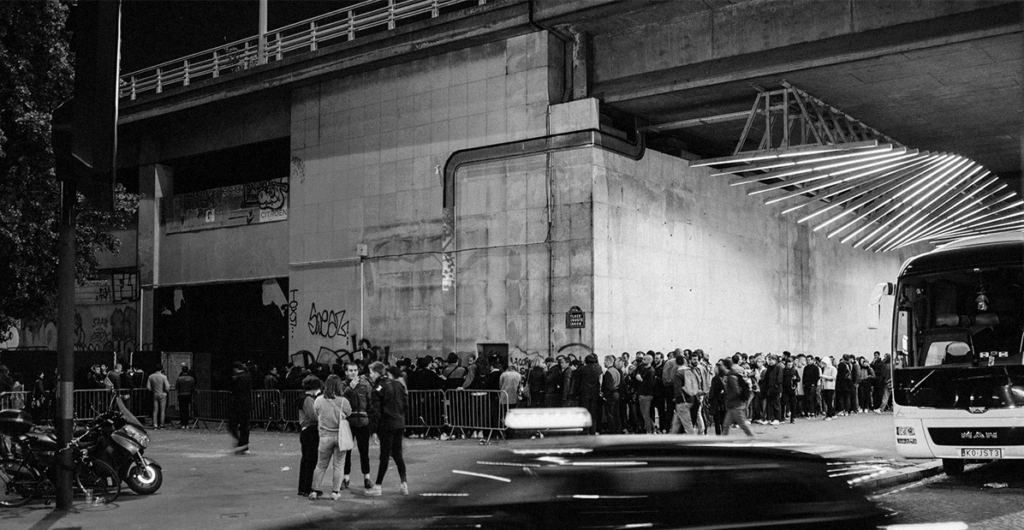
© Jacob Khrist